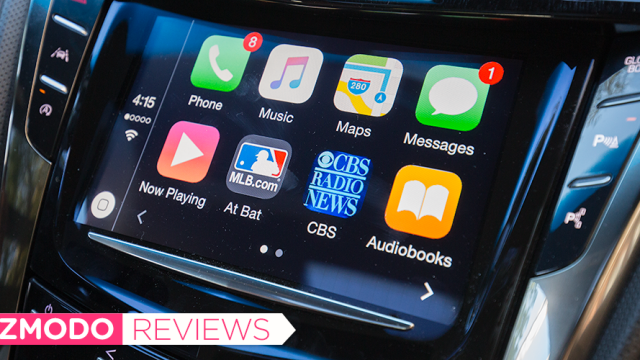The first time I saw CarPlay in action, I couldn’t believe it. You could plug your iPhone into the infotainment system and then get iOS on your dashboard?! It seemed like Apple finally found a way to turn an automobile into a rolling computer like Knight Rider.
But after spending a few days using CarPlay, reality set in. Turning your dashboard into just a huge iPhone is actually a terrible idea, if only because it would give people too many reasons to stop looking at the road. So Apple’s designed CarPlay to do a few things and do them well. Siri is central to the experience, but even Siri gets her wings clipped when you get on the road. That doesn’t mean the artificially intelligent KITT-wannabee wasn’t useful.
What is it?
CarPlay is Apple’s first big exploration into automobile software. Actually, that’s probably overstating things. If the model supports it, CarPlay will turn a car’s infotainment system (including some after market infotainment systems like Pioneer’s AVIC-8100NEX) into a simplified iOS interface. It’s not quite like having a giant iPhone on your dash, but it does let you use some features of some apps — namely Maps for navigation, Phone and Messages for communication, and Music for entertainment. Apple is also letting third parties develop apps with Carplay capabilities, but these are so far limited to radio and music apps, like Spotify.
Automakers are notoriously bad at software. This is an increasingly frustrating problem as drivers decide to juggle smartphones on the road instead of fiddling with a poorly designed infotainment center. However, since the infotainment centres in many new cars are essentially just giant touchscreens, companies like Apple and Android are working with manufacturers to help people use their phones more effortlessly and, thus, more safely.
CarPlay is specifically interesting right now. Over the summer, Apple said that CarPlay would be in 40 different models by year’s end. And just a couple days ago, reports surfaced that Apple would start shipping its own electric car within five years. So it’s not crazy to believe that Apple is vicariously testing out how its automotive software would work in CarPlay-enabled vehicles. If nothing else, Apple seems committed to letting developers build apps for cars, so it’s safe to say that roads are the next frontier for our connected lives.
Design
It’s simple: CarPlay looks like iOS for people with bad vision. This is not a joke. Apple actually says the interface is designed to create “an eyes-free experience.” In other words, you should never have to take your eyes off the road in order to interact with CarPlay. This is a bit of a stretch, but it’s also where Siri becomes important.
The home screen in CarPlay looks a lot like the home screen of an iPhone, except all of the icons are much larger and there is no dock. In the lower lefthand corner there’s a little button that will beckon Siri if you press and hold it. You can do this from the steering wheel, too, if your model comes with a button for voice commands. The apps themselves are more simplified, standardised versions of their regular iOS equivalents, and navigating through menus feels more like using an iPod than an iPhone. This is surely intentional since many cars’ infotainment system probably uses knobs, and CarPlay will let you use the knobs like the clickwheel on an iPod.
Getting Started
For my review, General Motors let me borrow a 2016 Cadillac CTS for a weekend. The fully loaded sedan came with all kinds of impressive dashboard features like the latest Cadillac Cue infotainment software and a head up display as well as semi-autonomous driving features like Lane Keep Assist and adaptive cruise control. These buttons, bells, and whistles were neat but not essential to enjoying the Apple CarPlay integration.
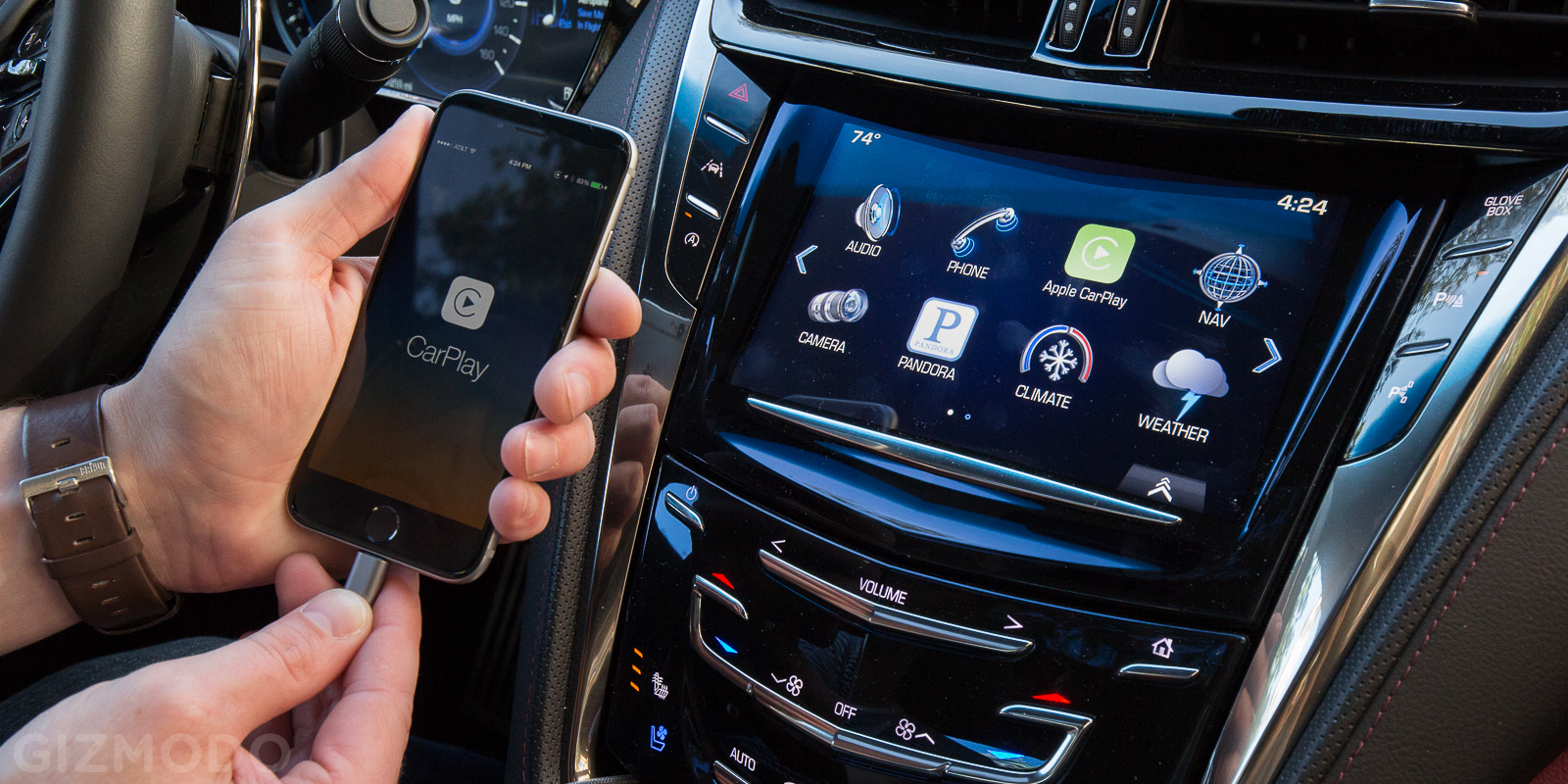
At the moment, you have to plug your iPhone directly into your car’s USB port in order to use CarPlay. (Developer previews of iOS have hinted that wireless CarPlay is on the way, but it’s unclear when.) So when you hop in the car, you have to connect a cable and unlock your iPhone before you can get started. The Cadillac CTS has a handy little compartment behind the dash, where you can plug in your phone and stash it so that you’re not tempted to use it while you’re driving. So for the most past, once I started driving, I didn’t touch my phone at all. I didn’t really want to, either, except for when CarPlay didn’t work.
The first time I fired up CarPlay, I went straight for the Spotify app (pictured below). It seemed cool that Apple was letting third parties develop car-specific apps, but I’m not sure how much engineering they’re really doing. Like I alluded to before, the menus in the app were a lot like the old iPod menus, but this makes great sense for music. I also checked out the Music app and it worked virtually the same as Spotify. There’s a noticeable absence of Apple Music features, though.
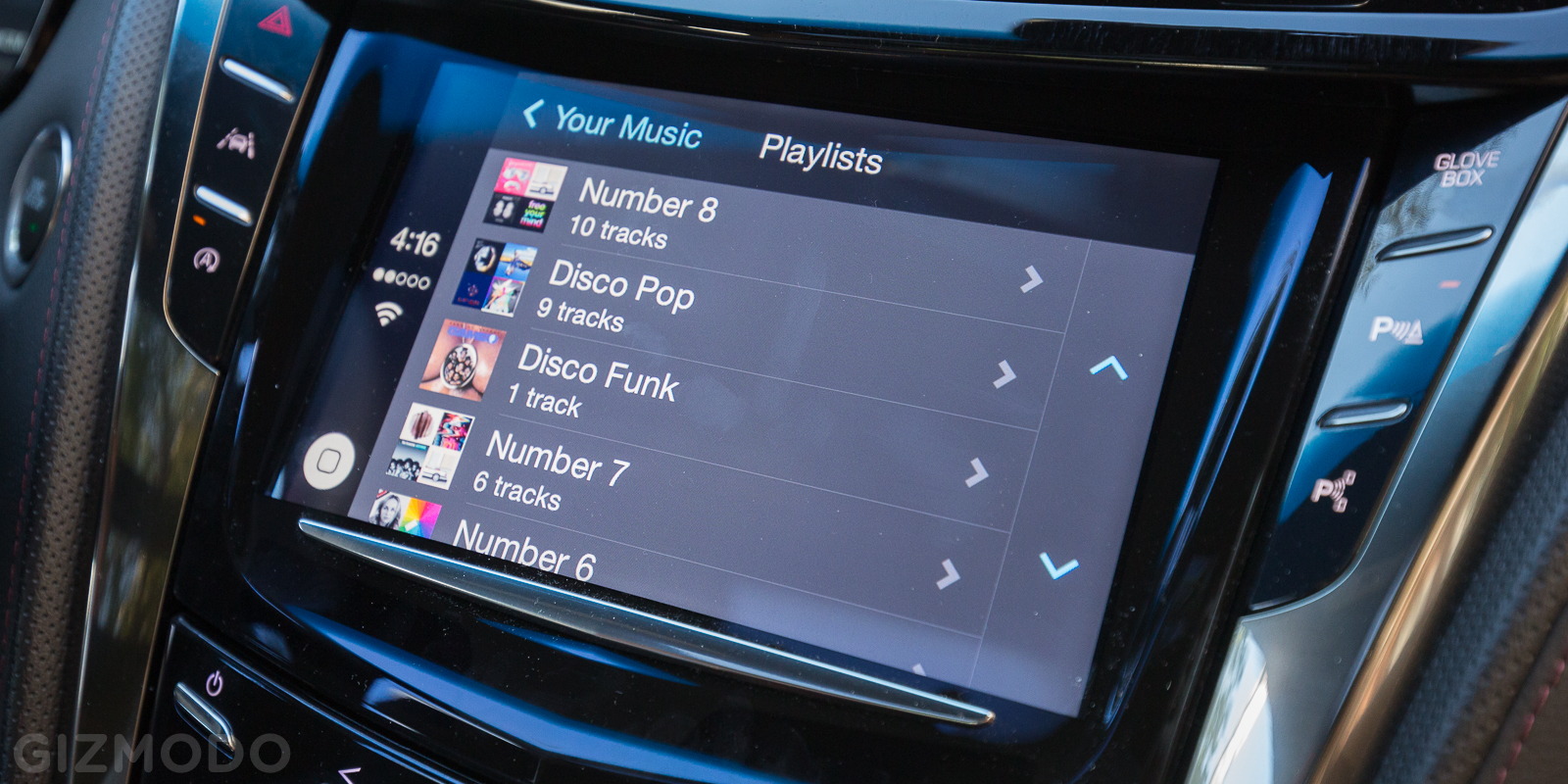
I noticed pretty quickly that the Cadillac’s touchscreen wasn’t as sensitive as, say, an iPhone’s. Scrolling was also limited to one flip of the finger. In other words, if you wanted to shoot to the bottom of a list, each flip only took you so far. Again, this makes sense since you want your gestures to be specific and predictable while driving. The endless scroll of an iPhone is a great way to get distracted by looking at a screen.
Tapping through the other apps, I quickly realised just how limited CarPlay is. If you’re not trying to call or text, pretty much your only options are navigating through Maps or listening to something with a music, radio, or podcast app. Is it sensible? Absolutely. Is it boring? Oh yes, intentionally so.
Driving With It
Like a responsible driver, I take a minute to get situated before I hit the gas pedal. So I queued up a Spotify playlist — something I used to do with a semi-functional FM radio transmitter that plugged into my phone — and looked up my destination in Maps, where I found a surprise. There is no keyboard in CarPlay. When you go to search for a destination, Maps pull up your favourite addresses, and if you tap the search icon, Siri asks you where you want to go. Say an address or “Siri take me home” or whatever, and the Siri charts the way. Pick a route and tap start, and Siri tells you where to turn. Of course, the navigation is only as good (or bad) as it is on your iPhone. Apple Maps has improved over the years, but I still prefer Google Maps which you can’t use with CarPlay — not yet, anyways.
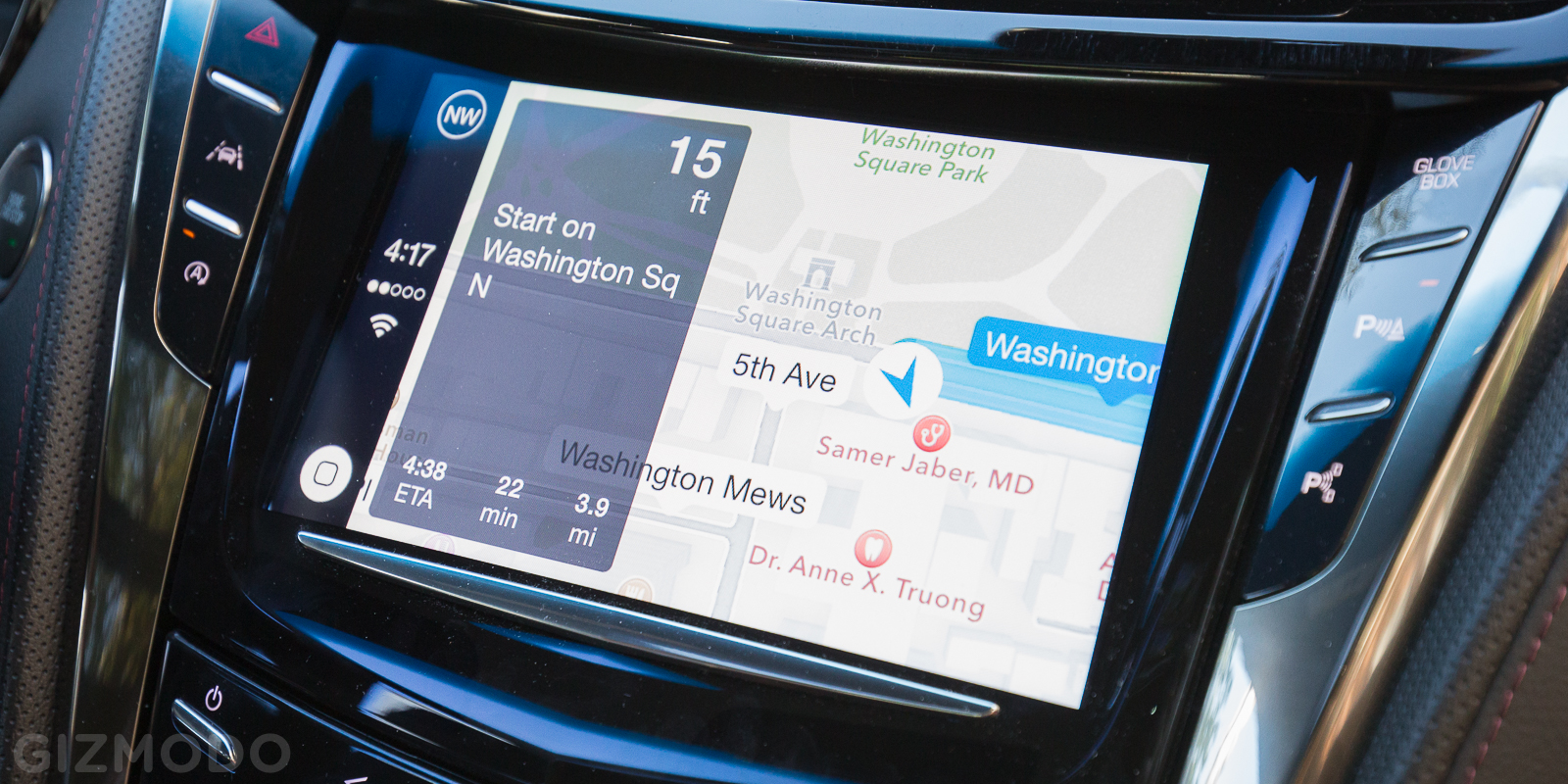
This all works great when you’re standing still. Once I was on the road and started testing out the other apps, however, I realised that there’s a bit of a learning curve when it comes to talking to your car. That tap-to-start thing in Maps for instance seems normal when you’re parked, but when you’re driving through city streets and want to change routes, it feels like you’re scrambling a bit to touch the right buttons. Luckily, I improved this fumbling dance to a more manicure manoeuvre over time.
But I never really caught on to the Messages workflow. This is presumably a marquee feature in CarPlay, and I’m personally a huge proponent of any technology that will stop people from texting and driving. Other car companies, including GM and Ford, have their own talk-to-text features, but they’re famously bad. CarPlay’s Messages app actually works pretty well. You summon Siri, say you want to text Bob, and then just say what you want to say. Siri repeats the text back to you and asks if you want to send. You say “yes” and it sends. (This is basically how it works with Siri in regular old iOS, by the way.)
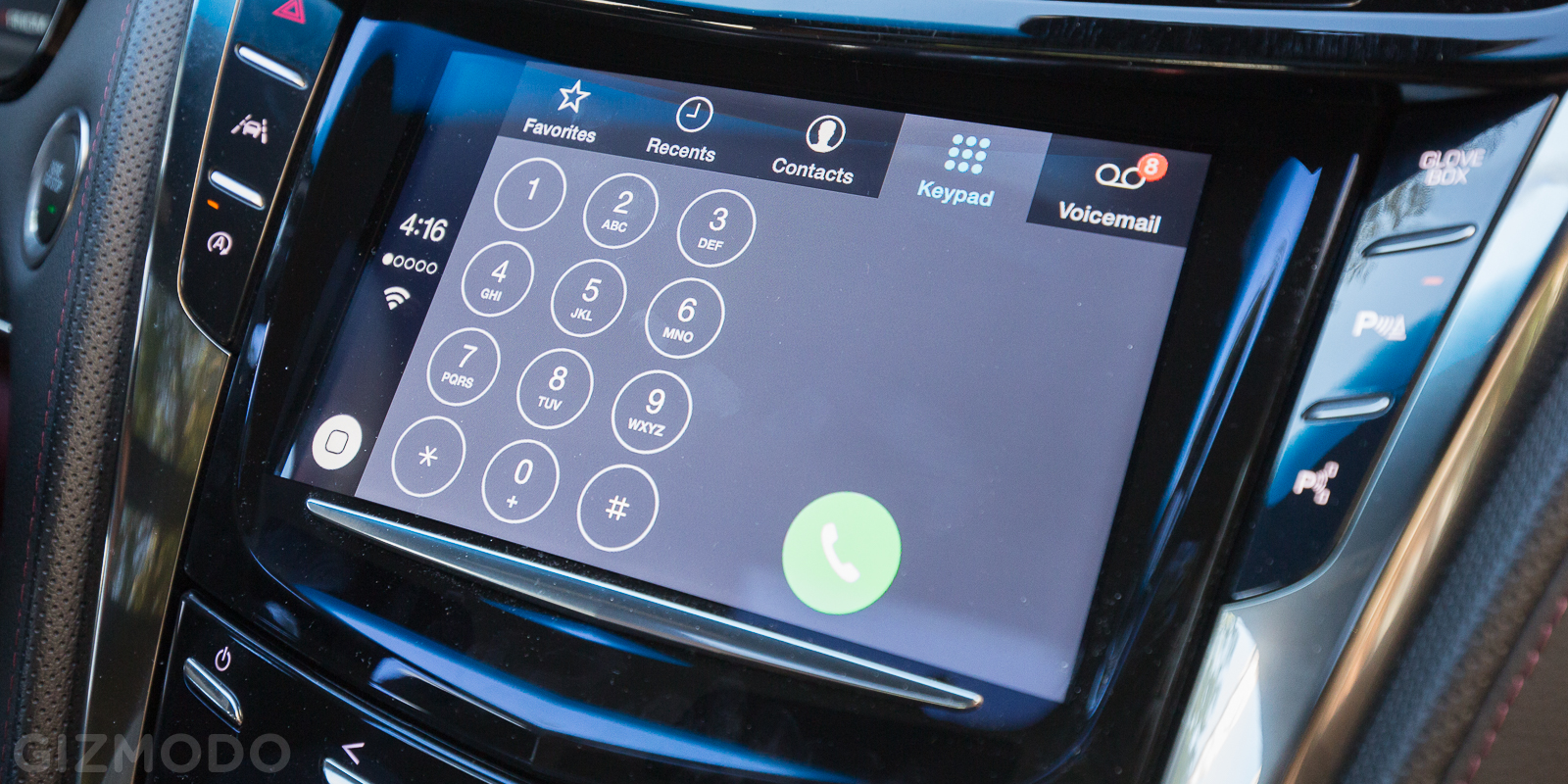
The trouble is, an average teenager could send about 37 texts in the time it takes Siri to go through her safety-first process. I found myself reaching for my phone, so that I could skip the many steps, but I usually just decided to call the person instead. This worked brilliantly. Texting and driving is still stupid dangerous. I’m just not sure Siri’s solution is going to stop people from trying to tap out a text on a tiny keyboard while zooming down the highway.
Siri does some other stuff, too, but nothing too fancy. You can tell Siri, “Play Daft Punk,” and a Daft Punk track will start playing, if you have it in your Music library. You can ask Siri for baseball scores, and she’ll give you a rundown. But if you try to ask Siri to search the web for something while driving, she’ll shut you down. No Googling and driving. And you can forget about watching YouTube videos.
Being boring is the point
So in the end, CarPlay doesn’t do a lot, but that’s intentional. The basic features work pretty well, but everything feels like an incremental improvement over existing feature-rich infotainment systems. In fact, Cadillac’s CUE software was slightly better in certain regards, like its ability to show turn-by-turn directions on the head up display. CarPlay surely lacks features that other carmakers’ native systems have, especially considering that CarPlay can’t access the car’s climate control, door locks, or really anything that’s not on your iPhone. All that said, simplicity is what cars need on the dashboard.
Autonomous cars are somewhat inevitable. Heck, even Apple might build one eventually. For now, however, driving continues to be a dangerous activity, and distractions are to blame. The National Highway Traffic Safety Administration says at least nine people are killed by distracted driving every day. The fact that Apple doesn’t give you more apps to distract you is exactly the point.
Instead of some Knight Rider fantasy I’d always hoped for — one where I could use Siri to surf the internet on the highway — CarPlay basically gave me a really nice radio with a built-in navigation. But that’s not a bad thing. Siri might be boring in the car, but she does come in handy. I bet she could save some lives someday, too.
Should I Buy It?
Here’s the really good news: CarPlay is free! Here’s the bad news: You have to buy a car or an expensive aftermarket infotainment system that supports it. For now, GM brands like Chevrolet and Cadillac are adopting CarPlay functionality most aggressively. Eventually, Apple wants CarPlay to work in all cars and perhaps even its own. But that future is still pretty far away.
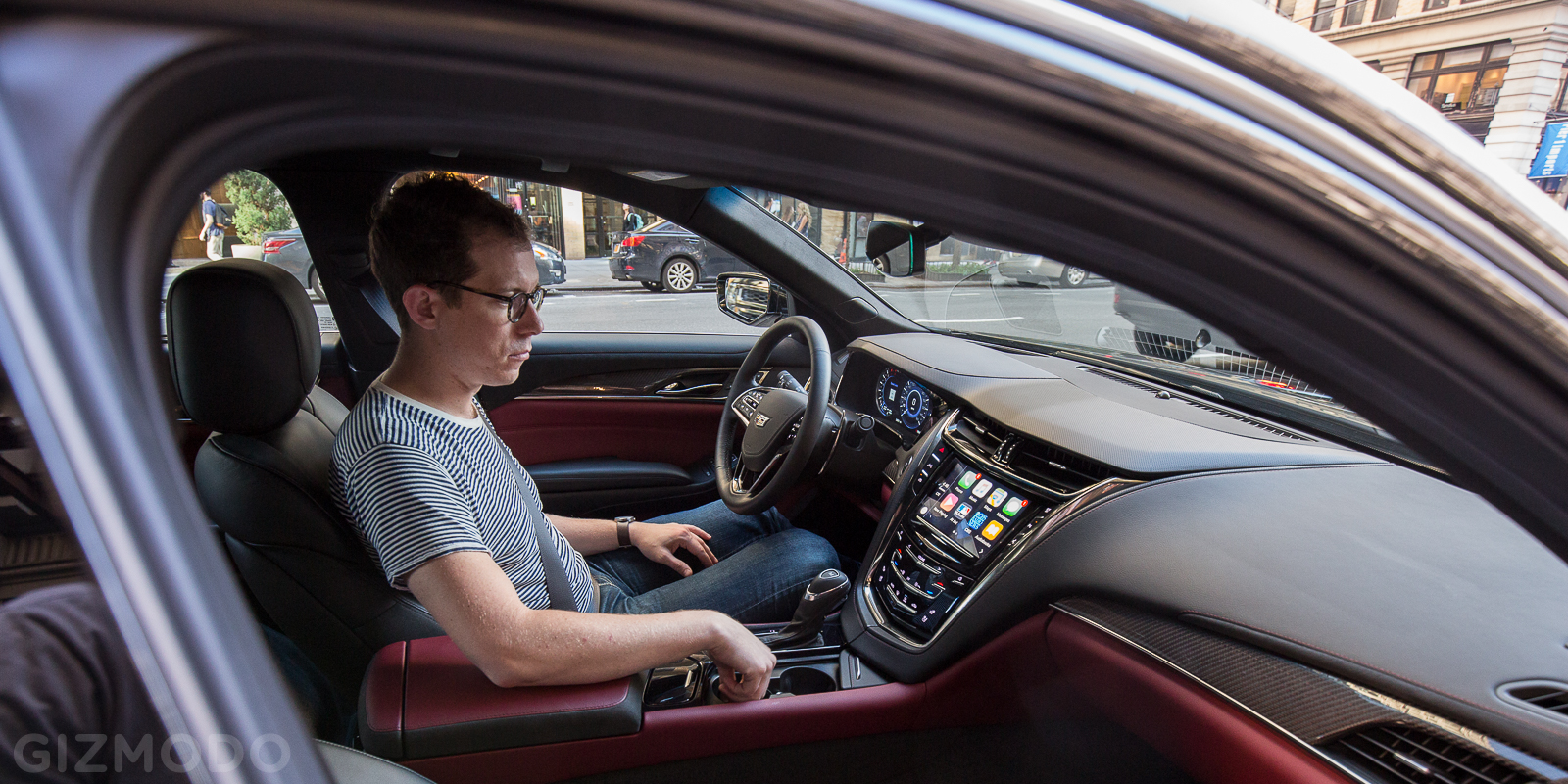
This is to say, you should consider CarPlay functionality if you’re in the market for a new car, but don’t make it a dealbreaker. It’s not out of the question that a software update could bring CarPlay to any car with a touchscreen infotainment system. If it does, you’re in luck. A pared-down version of Siri and a safer screen experience makes CarPlay super useful, if a little boring. If you really want to surf the internet while you’re travelling, though, take an aeroplane.
Photos and Video by Michael Hession
